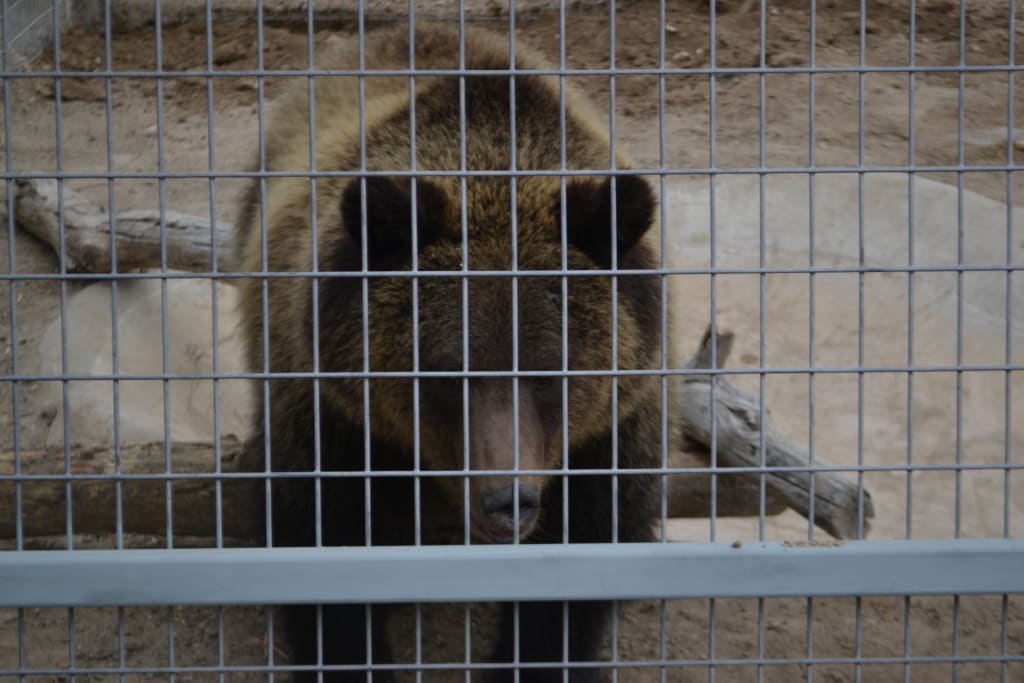Delisting of the Yellowstone Grizzly Bear Population From the Endangered Species List and the Trump Administration's Vital Mistake
What it means for a species to be 'endangered' is changing.

Months before the delisting of Grizzlies in Wyoming, Montana planned to remove the federal Endangered Species Act protection whilst planning for their next grizzly hunting season. Wildlife advocates were concerned the population was still too vulnerable for a definitive hunt, but state officials claimed that the rules set in place were non-threatening to the bear population. Prior to any of the grizzly populations being delisted in Idaho, Montana, and Wyoming, the states were required to outline what a hunting season would look like. "The three states have signed off on an agreement to jointly manage grizzly bears to ensure their population numbers don't drop too much because of overhunting" (Volz). The agreement also includes a yearly review of the population to determine the amount killed off by hunting each year. The states agreed that if the Yellowstone population drops below 600 bears, then no hunting will be allowed. What truly matters most is that the population is stable, not the size of the group. While the idea may seem promising, it is unlikely that these events will be followed through with. Hunters in Montana would be allowed to kill only a single bear within their entire lifetime and whoever received a license would have to wait seven years before even having the opportunity to have another. Ultimately, only 17 animals out of the 700 would be available for hunting in the Yellowstone region. Montana's quota was expected to be less than ten bears a year, but even with these regulations set in place, there is still no way to prevent the 3-S treatment (Shooting, Shoveling, and Shutting Up). The 3-S treatment is an illegal process that is used for dealing with unwanted or unwelcome pests and occurs primarily in rural areas. It is also used to eradicate endangered species, sick livestock, and even pets. This practice is sometimes used as a defense mechanism if an endangered animal is harming livestock, but other times it is used as a way to get out of the federal consequences of illegally killing an animal. Since Wyoming, Idaho, and Montana are on their way to opening a hunting season that will hardly allow any grizzly bears to be killed, it seems as though there will be a major boost in illegally killing animals simply just for something as insignificant as a trophy. Before the US Wildlife and Fish Service even have their “annual meetings,” the species could be wiped from the Yellowstone National Park area due to many of the legal activities around an all too tempting prize. The National Rifle Association argues that hunting Yellowstone-area Grizzlies can be a public safety issue and compare it to how their clients were previously mauled by grizzly bears. The NRA’s main argument is that Grizzlies need to learn to fear the scent of humans so they don’t continue to follow it and find even more trouble. Biologist’s studying the Yellowstone grizzly population doubt the NRA’s assumption is even remotely valid and rebutted saying that intensive bear hunting can change and influence the species’ behavior. In the end, nothing we do is going to push grizzlies to avoid and dread humans. Grizzly bears understand they are capable of killing a human and nothing will change that sort of instinctive behavior.
Climate change is evolving everything we've ever known about Yellowstone National Park, and the grizzly bears' diet is beginning to change immensely. Most environmentalist groups are planning to sue over the delisting due to the threat of climate change imposes. Multiple Universities have indicated that grizzly bears forage for whitebark pine seeds as an adequate food source and only a few bears have been able to suggest that Grizzlies have moved away from whitebark and turned to more berries and plants. Whitebark pine trees are now listed as endangered and warming temperatures have led to milder winters and can cause beetle infestations to be continuously more common. Scientists have also chosen to argue that the government and Trump Administration have failed to acknowledge the imperative role climate change is truly playing in beetle infestations. The denial is an example of the Trump Administration's refusal to take the effects of climate change seriously. "There are a lot of people within the agencies that are well aware and concerned, but there are also those whose response is denial that there's a real critical issue here" (Sheppard). Due to the Trump Administration not realizing the effects of climate change, it could mean the fate of multiple different species on their hands. It is clear we are ultimately unable to trust this administration in making good science-based decisions. Global temperatures are one degree average higher than the usual temperatures, but the Greater Yellowstone Ecosystem is even higher than the average at 1.4 degrees higher than last century. Due to the temperatures on the constant rise, beetles have gained the opportunity to lodge themselves in higher altitudes where whitebark pine trees live. Scientists reveal that studies have shown that warmer temperatures are able to speed up the beetles' reproductive cycle. According to the federal government, this beetle problem "peaked" and has never come back from those numbers. Federal agencies don't even feel the need to include climate change as a significant factor when considering endangered species. The severity of the beetle outbreak is attributed to warmer winters at higher elevations and the future of whitebark pine trees remain uncertain.
Too many scientific groups believe that the government has truly failed when it comes to considering how climate change and beetles will affect the fate of the Yellowstone grizzly bear and because of this, environmentalists are gearing up for another fight to challenge the federal government's decision to delist the grizzly bears. And due to the Trump Administration being so unwilling to take climate into account, that is how the environmentalists won the first effort towards the bears not being delisted from the threatened species list. The government is ignoring a true biological threat and it is a big mistake on their behalf. It has been made clear that what the grizzly bears within Yellowstone National Park really need is for the Trump Administration to take climate change seriously.
Whitebark pine seeds can live up to 1,000 years and are a food source for the Grizzlies in the Yellowstone region. Studies have proven that the beneficial pine seeds help the Grizzlies in numerous ways. For example, the bears are less likely to forage for food around humans, along with female bears being able to birth more cubs and have successful pregnancies than those who don't have access to whitebark pine tree seeds. Also, whitebark pine nuts help bears fatten up in order to hibernate in the winter. Because whitebark pine trees grew at higher elevations, meant they would not have to deal with pine beetles, but climate change has caused the conditions to improve in favor of the mountain pine beetles. Mountain pine beetles attack mature pines and kill the inner bark enough to support their larvae. Unfortunately, whitebark pine seeds are dramatically declining in the Yellowstone National Park area. With more and more beetle infestations, whitebark pine seeds are becoming continually scarcer. Whitebark pine trees are basically defenseless to these pests. Environmentalists and scientists claim that grizzly bears are still in peril because whitebark pine had previously had a major beetle infestation. A good year for whitebark pine is a good year for grizzly bears and whitebark pine trees don't have many good years these days. Evidence has suggested that bears have already been responding to the decline in whitebark pine seeds and have found other adequate food sources. Although, grizzly bears are not dependent on whitebark and usually only eat it when it is completely available. When whitebark pine trees are unavailable, Grizzlies are able to opt for different foods since they are omnivores, and the bears in the Yellowstone region can eat up to 75 different foods. But Grizzlies in search of new food sources may leave protected areas and unintentionally confront humans who may perceive the bears as nothing other than pests. It is certain that the lack of whitebark pine seeds will send bears farther for food and an increased chance of an encounter with humans and will end up with too many bears killed for only their natural instincts. "...researchers outside the federal government say federal agencies are too bullish when it comes to the whitebark and the bears" (Sheppard). The federal government refuses to recognize that the beetle outbreak persists and are unable to see that the white bark pine is a major food source for grizzly bears. By losing the whitebark pine tree, it could be the last straw on the camel's back before this already precarious situation is made infinitely worse.
On the contrary, taking the grizzly bear off of the Endangered Species list ultimately has to do with the integrity of the Endangered Species Act. Wyoming Governor Matt Mead has spent much of his time advocating for the grizzly bears to be pulled off the threatened list. He has also previously stated that if bears are managed appropriately, then hunting decisions will soon follow. Also, the grizzly population is said to have been kept stable since 2002. The Interior Department even commented saying that the grizzly bears surrounding Yellowstone National Park have been able to find other food sources and that no decline should take place within the Yellowstone ecosystem.
"The credibility of the Endangered Species Act will continue to erode. There is a limit to political and public tolerance for sacrifice on behalf of wildlife. It should not be wasted on those species that have recovered, especially when we've got so many more waiting in line" (Rinella).
Hunters accuse the Endangered Species Act itself as not being enough when it comes to saving a species. Section nine of the ESA states that it is unlawful for any person "to harass, harm, pursue, hunt, shoot, wound, kill, trap, capture, or collect, or to attempt to engage in any such conduct." These regulations seem reasonable in order to save a species, but it has led to deadly consequences for the species it was supposed to protect. This section has even been extended to include destroying habitats of listed species. For example, someone could be prosecuted for cutting down a section of trees on our own land, but since those trees were supposedly used to provide a threatened species with a habitat, then that person could potentially be facing multiple fines, along with jail time. The Endangered Species Act has perverse effects that definitely include pre-emptive actions. Managing the Endangered Species list is expensive, as Wyoming has spent almost two million dollars on grizzly bear research and conservation. Only three dozen species have even been taken off of the Endangered Species list since their numbers have drastically recovered. A lot of the money doesn't even go to the bears but instead is used for public education programs while costing taxpayers millions and diverting the resources. Once Yellowstone Grizzlies have been delisted, it will be the responsibility of the State Fish and Wildlife Service in Idaho, Montana, and Wyoming. These state services will be able to handle to bears using their money and expertise. Voluntary conservation efforts have failed to address the true problem. Environmental groups using the Endangered Species Act have not been good for endangered species or to private landowners. It seems as though rewarding private landowners for their contribution to conserving wildlife would be in environmentalist's and the public's best interest. Not to mention that hunting will help with population control along with being a tool to use when bears are in areas that have the potential for human confrontations. Any grizzly killed will be added on toward a collective mortality ceiling and will therefore never go past the threshold.
Overall, it is detrimental for the Endangered Species Act to continue to protect the Yellowstone National grizzly bears because if we lose this species, it could create a number of problems throughout the Greater Yellowstone Ecosystem. grizzly bears have proven to be important to Idaho, Montana, and Wyoming since we have spent so much money on attempting to save them and taken so many precautions in order to prevent this beautiful species from being lost forever. Hunting may have the potential of serving as population control, but with so few bears up for grabs, it could end up causing many more problems by tempting hunters to kill a species that wouldn't even be available for most. Although Idaho, Montana, and Wyoming have agreed on regulation for their hunting seasons and set a threshold for the population, it is important that we base this off of whether the population is stable and not based off of the size of the population. Regardless if the Trump Administration has chosen to deny climate change, it is a very real thing that will only grow more and more as the years pass while taking its toll on certain species and plants. This new administration has quickly proven that they are unable to make sound decisions based on scientific fact and ultimately turn to their own opinion in order to destroy the balance of a substantial ecosystem. Only the programs (such as The Humane Society and the National Parks Conservation Association) who are actually willing to take the situation into their own hands will truly end up making a difference in a political society that goes off of their own "best judgement." In the end, we will see what has become of the Yellowstone National Park grizzly bears once hunting, political standpoints, and the destruction of important resources has taken its toll and we are left with the blood of a lost species on the hands of the people who were most capable of preventing the loss of a species that currently controls an entire ecosystem.
Works Cited
Anderson, Terry L. "When the Endangered Species Act Threatens Wildlife." Wall Street Journal, 21 Oct, 2014, pp. p. A.15, SIRS Issues Researcher, https://sks.sirs.com.
Lewontin, Max. "No Longer Endangered? Montanans Prepare for Grizzly Bear Hunt." Christian Science Monitor, 06 May, 2016, SIRS Issues Researcher, https://sks.sirs.com.
Matthews, Susan. "Grizzly Bears Are Now the Victims of the Trump Administration's Climate Denialism." Slate, 23 Jun, 2017, http://www.slate.com/articles/health_and_science/science/2017/06/we_can_t_trust_this_administration_s_climate_decisions.html.
Sheppard, Kate. "In The American West, A Battle Unfolds Over Bugs, Climate Change And The Fate Of An Iconic Species." Huffington Post, 31 Jan. 2014, https://www.huffingtonpost.com/2014/01/31/grizzly-bears-climate-change_n_4652044.html.
Rinella, Steven. "The Problem with Protecting Grizzly Bears." SIRS Issues Researcher, 09 May, 2016, https://sks.sirs.com.
Volz, Matt. "Montana Sets Grizzly Hunt Rules Ahead of Federal Decision." Great Falls Tribune, 13 Jul, 2016, SIRS Issues Researcher, https://sks.sirs.com.
Associated Press. "US to Review Ended Protections for Yellowstone Grizzly Bears." VOA, 06 Dec, 2017, https://www.voanews.com/a/united-states-to-review-ended-protections-for-yellowstone-grizzly-bears/4152235.html.
About the Creator
Sierra Spears
• Zookeeper in Training 🐝 • Aspiring Conservationist 🌎 • Change the World 🗺






Comments
There are no comments for this story
Be the first to respond and start the conversation.